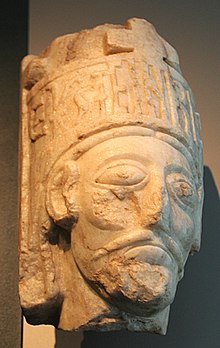Munkeliv monastery
The Munkeliv Abbey was an important medieval monastery in Bergen (Norway) . It was withdrawn in favor of the Danish crown during the Reformation . Remnants of the former monastery are no longer visible today.
History of the Benedictine monastery
The Munkeliv monastery was founded around 1110 by King Øystein Magnusson as part of his expansion of the city of Bergen as a Benedictine monastery and consecrated to the Archangel Michael . Together with the prosperous city of Bergen, it developed into one of the most important monasteries in Norway. The great plague of 1349 and the accompanying depression in Norway brought a turning point. At the end of the 14th century, the monastery buildings were destroyed in the attack by the Rostock and Wismar Brothers of Vitality on April 22, 1393. The good financial resources of the monastery made the reconstruction possible for the Benedictines.
Birgitten Monastery
At the end of the first quarter of the 15th century, with the blessing of the Vatican, the monastery passed from the order of the Benedictines to the young Birgit order , which was rapidly expanding from the main monastery in Vadstena , which Birgitta of Sweden had founded around 1350 and which was founded in 1370 by Pope Urban V. had been recognized. As Birgittenkloster, Munkeliv Monastery was a double monastery for monks and nuns. In terms of importance and reputation, the monastery soon came first in the order, alongside the respected monasteries Mariendal near Reval in Estonia, Marienwohlde monastery near Mölln near Lübeck and Mariakron monastery in Stralsund .
In 1455 the buildings of the Munkeliv monastery were again badly damaged by fire when the merchants of the Hanseatic League pursued the Danish governor Olav Nilsson , the commander of the Bergenhus fortress . He had sought refuge in the monastery, so that the German merchants attacked the monastery. Monks and nuns from the monastery were relocated to the Hovedøya monastery near Oslo . The reconstruction of the Munkeliv monastery was initially carried out by the Cistercians and it was not until 1480 that the monastery was taken over by Birgitten , who remained until the Reformation. Around 1496, the bailiff and the city council of Bergen complained by letter to the mother house in Vadstena about the way of life of the members of the Munkeliv monastery. The nuns had their own house near the Deutsche Brücke near the houses of the friller , the concubines of German merchants. But the way of life of the monks of the monastery was also considered unchristian. In 1523, on behalf of King Frederik I, Vincens Lunge came to Bergen to first drive the supporters of the deposed King Christian II out of the possession of the Bergenhus Fortress. The Lübeckers allied with him and members of the Hansekontor in Bergen did not storm Bergenhus with him, but made a sortie on the Norwegian part of the city of Bergen. Continued unrest in Bergen was the result and in the course of the Reformation the monastery was largely appropriated in favor of the crown, while Lunge was awarded the monastery Nonneseter by the king . The buildings in Munkeliv were partly occupied by the Bishop of Bergen as a residence and the monastery church was elevated to the status of a cathedral church. In 1536 the whole complex burned down again and was not built over again until the 19th century. The cathedral church was also relocated again: in 1537 the church of the Franciscan monastery became the cathedral church of St. Olav .
Aftermath
The Romanesque bust of the founder Øystein Magnusson from the former monastery church is in the Bergen Museum . It was discovered in 1860 by the Norwegian archaeologist Nicolay Nicolaysen during excavations on the site of the former church. Hans-Emil Lidén ascribes the influence of a Lombard sculpture school to the marble bust and the rest of the architectural sculpture, with reference to similar works in Speyer . It is considered to be the oldest portrait of a Norwegian.
There are also traces of high culture from the Birgitten. In the library of the Metropolitan Chapter at Prague Castle is the Kalendarium Munkalivense, also known as the Psalterium Birgittae , a manuscript whose illuminations were made around 1450 by the nun Birgitta Sigfusdatter in the Munkeliv monastery. According to the judgment of the Swedish imperial librarian Collijn, it is one of the "most beautiful manuscripts that were created in Scandinavia in the 15th century". The Danish Royal Library keeps other manuscripts from Munkeliv Monastery . The Munkeliv monastery is considered to be exceptionally well documented in terms of historical sources.
literature
- Henrik v. Achen: “Hanseatic” art in Bergen during the late Middle Ages: Import or local production? In: Bergen and the German Hanseatic League. Pp. 59-85.
- Richard Carstensen: Bergen - development picture of a Norwegian port city, especially with regard to Bergen's relationship with the Hanseatic League. In: Communications from the Geographical Society in Lübeck. Issue 53, Lübeck 1973.
- Isak Collijn : Kalendarium Munkalivense, a Swedish-Norwegian Birgittinerkalendarium. In: Aloys Bömer , Joachim Kirchner (Hrsg.): Medieval manuscripts: palaeographic, art historical, literary and library history studies. Festival ceremony for Hermann Degering's 60th birthday . Hiersemann, Leipzig 1926. Reprint: Olms, Hildesheim, New York 1973, ISBN 3-487-04702-0 , pp. 82-92.
- Hans-Emil Lidén, Ellen Marie Magerøy: Norges kirker, Bergen. Volume 1. Oslo 1980, ISBN 82-05-12367-5 .
- Ingvild Øye (Ed.): Bergen and the German Hanseatic League. Bergen 1996, ISBN 82-90289-65-0 .
- Marek Suchý: Bergenský žaltář a kapitulní knihovna. In: Příběh Pražského hradu. Prague 2003, pp. 204-205.
Web links
Individual evidence
- ↑ N. Nicolaysen: Om Munkelifsklosteret i Bergen og det levninger. In: FNFB. Aarsber. 1860, pp. 59-79.
- ^ Facsimile of a manuscript in Copenhagen
Coordinates: 60 ° 23 ′ 42 " N , 5 ° 18 ′ 54.4" E

